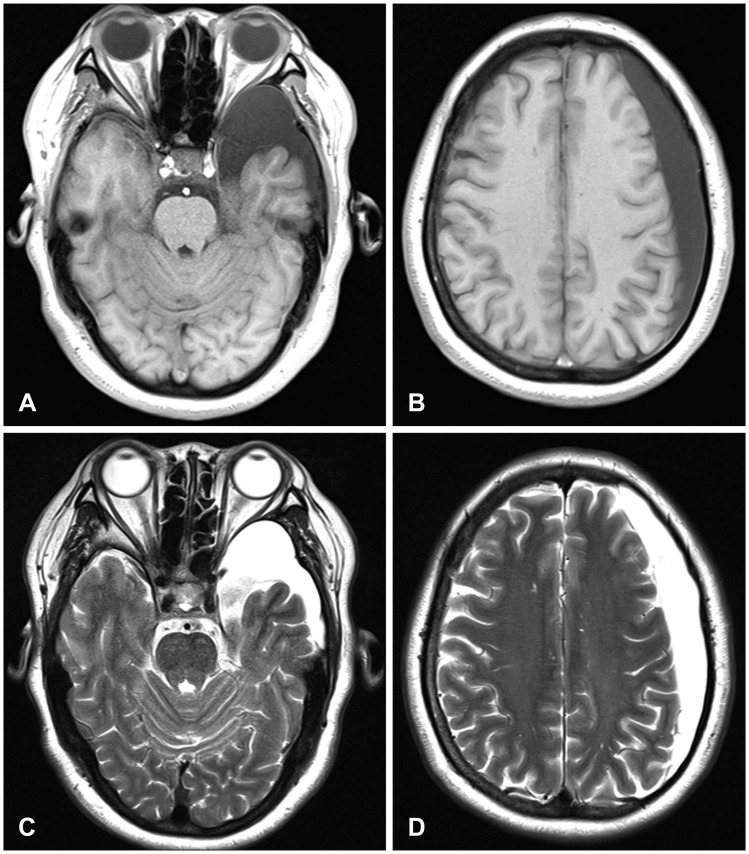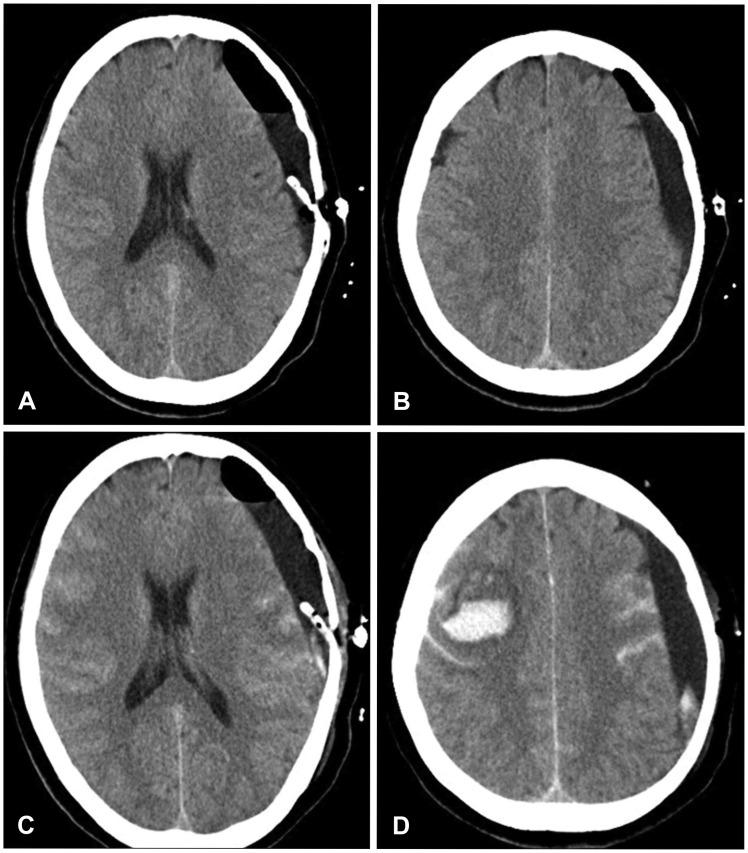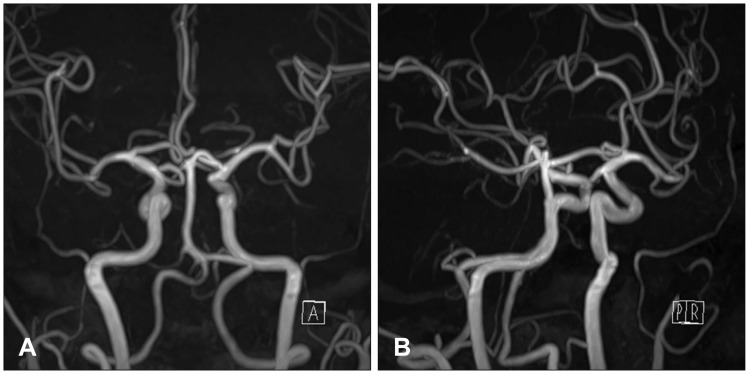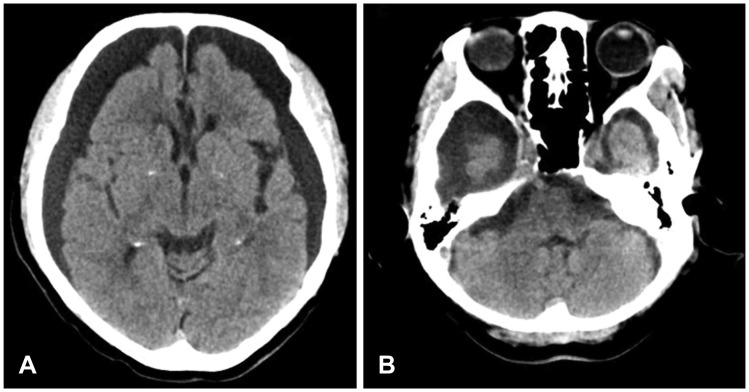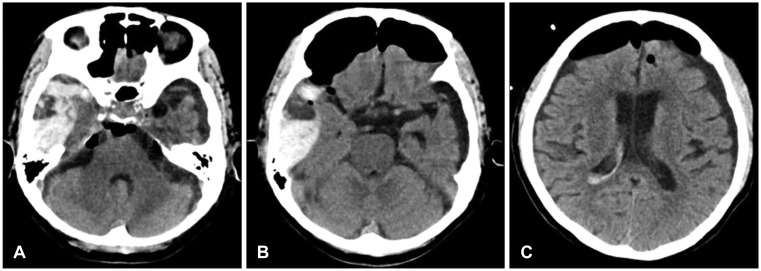Korean J Neurotrauma.
2017 Oct;13(2):144-148. 10.13004/kjnt.2017.13.2.144.
Remote Hemorrhage after Burr Hole Drainage of Chronic Subdural Hematoma
- Affiliations
-
- 1Department of Neurosurgery, Pusan National University Yangsan Hospital, Pusan National University School of Medicine, Yangsan, Korea. mole83@daum.net
- KMID: 2394550
- DOI: http://doi.org/10.13004/kjnt.2017.13.2.144
Abstract
- Chronic subdural hematoma (CSDH) and symptomatic subdural hygroma are common diseases that require neurosurgical management. Burr hole trephination is the most popular surgical treatment for CSDH and subdural hygroma because of a low recurrence rate and low morbidity compared with craniotomy with membranectomy, and twist-drill craniotomy. Many reports suggest that placing a catheter in the subdural space for drainage can further reduce the rate of recurrence; however, complications associated with this type of drainage include acute subdural hematoma, cortical injury, and infection. Remote hemorrhage due to overdrainage of cerebrospinal fluid (CSF) is another possible complication of burr hole trephination with catheter drainage that has rarely been reported. Here, we present 2 cases of remote hemorrhages following burr hole trephination with catheter drainage for the treatment of CSDH and symptomatic subdural hygroma. One patient developed intracerebral hemorrhage and subarachnoid hemorrhage in the contralateral hemisphere, while another patient developed remote hemorrhage 3 days after the procedure due to the sudden drainage of a large amount of subdural fluid over a 24-hour period. These findings suggest that catheter drainage should be carefully monitored to avoid overdrainage of CSF after burr hole trephination.
Keyword
MeSH Terms
Figure
Cited by 1 articles
-
Rapid Spontaneous Resolution of Contralateral Acute Subdural Hemorrhage Caused by Overdrainage of Chronic Subdural Hemorrhage
Minwook Yoo, Jung-Soo Kim
J Neurocrit Care. 2018;11(2):119-123. doi: 10.18700/jnc.180051.
Reference
-
1. Bilginer B, Onal MB, Oguz KK, Akalan N. Arachnoid cyst associated with subdural hematoma: report of three cases and review of the literature. Childs Nerv Syst. 2009; 25:119–124. PMID: 18839182.
Article2. Cenic A, Bhandari M, Reddy K. Management of chronic subdural hematoma: a national survey and literature review. Can J Neurol Sci. 2005; 32:501–506. PMID: 16408582.
Article3. Cohen-Gadol AA. Remote contralateral intraparenchymal hemorrhage after overdrainage of a chronic subdural hematoma. Int J Surg Case Rep. 2013; 4:834–836. PMID: 23959412.
Article4. Kudo H, Kuwamura K, Izawa I, Sawa H, Tamaki N. Chronic subdural hematoma in elderly people: present status on Awaji Island and epidemiological prospect. Neurol Med Chir (Tokyo). 1992; 32:207–209. PMID: 1378564.
Article5. Kwak YS, Hwang SK, Park SH, Park JY. Chronic subdural hematoma associated with the middle fossa arachnoid cyst: pathogenesis and review of its management. Childs Nerv Syst. 2013; 29:77–82. PMID: 22914923.
Article6. Mori K, Yamamoto T, Horinaka N, Maeda M. Arachnoid cyst is a risk factor for chronic subdural hematoma in juveniles: twelve cases of chronic subdural hematoma associated with arachnoid cyst. J Neurotrauma. 2002; 19:1017–1027. PMID: 12482115.
Article7. Ogasawara K, Ogawa A, Okuguchi T, Kobayashi M, Suzuki M, Yoshimoto T. Postoperative hyperperfusion syndrome in elderly patients with chronic subdural hematoma. Surg Neurol. 2000; 54:155–159. PMID: 11077097.
Article8. Page AC, Mohan D, Paxton RM. Arachnoid cysts of the middle fossa predispose to subdural haematoma formation fact or fiction. Acta Neurochir Suppl (Wien). 1988; 42:210–215. PMID: 3189011.
Article9. Ramachandran R, Hegde T. Chronic subdural hematomas-causes of morbidity and mortality. Surg Neurol. 2007; 67:367–372. PMID: 17350403.
Article10. Rohde V, Graf G, Hassler W. Complications of burr-hole craniostomy and closed-system drainage for chronic subdural hematomas: a retrospective analysis of 376 patients. Neurosurg Rev. 2002; 25:89–94. PMID: 11954771.
Article11. Rusconi A, Sangiorgi S, Bifone L, Balbi S. Infrequent hemorrhagic complications following surgical drainage of chronic subdural hematomas. J Korean Neurosurg Soc. 2015; 57:379–385. PMID: 26113968.
Article12. Santarius T, Kirkpatrick PJ, Ganesan D, Chia HL, Jalloh I, Marcus H, et al. Randomized controlled trial of the use of drains versus no drains after burr hole evacuation of chronic subdural hematoma: 900. Neurosurgery. 2009; 65:401.13. Santarius T, Lawton R, Kirkpatrick PJ, Hutchinson PJ. The management of primary chronic subdural haematoma: a questionnaire survey of practice in the United Kingdom and the Republic of Ireland. Br J Neurosurg. 2008; 22:529–534. PMID: 18686063.
Article14. Shrestha R, You C. Spontaneous chronic subdural hematoma associated with arachnoid cyst in children and young adults. Asian J Neurosurg. 2014; 9:168–172. PMID: 25685210.
Article15. Sturiale CL, Rossetto M, Ermani M, Volpin F, Baro V, Milanese L, et al. Remote cerebellar hemorrhage after supratentorial procedures (part 1): a systematic review. Neurosurg Rev. 2016; 39:565–573. PMID: 26846668.
Article
- Full Text Links
- Actions
-
Cited
- CITED
-
- Close
- Share
- Similar articles
-
- Cerebellar Hemorrhage after Burr Hole Drainage of Supratentorial Chronic Subdural Hematoma
- Burr Hole Drainage versus Small Craniotomy of Chronic Subdural Hematomas
- Delayed Onset Acute Subdural Hematoma after Burr Hole Drainage in a Patient with Chronic Subdural Hematoma and Liver Cirrhosis
- Factors Affecting the Reaccumulation of Chronic Subdural Hematoma after Burr-hole Trephination and Closed-system Drainage
- Delayed Cerebellar Hemorrhage after Supratentorial Burr-Hole Drainage

